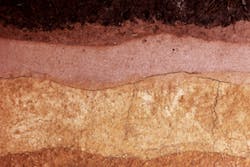Part one of this story can be found here.
Suppress That Dust!
From its offices in North Andover, MA, chemical giant Rohm and Haas Company supplies the industry with PaveCryl Suppress, a product that offers dust suppression and road stabilization. According to the company, the vinyl/acrylic emulsion provides optimum penetration and bonding when applied to fine or granular materials such as soil or dust-producing gravel. Treating an area with PaveCryl Suppress results in a durable water-resistant surface.
“Although it’s water-resistant, the surface is still permeable,” says Anthony Mariniello of Rohm and Haas’s Road Construction Chemical Group. “And it is, of course, a water-based product. When applied to a surface at dust-suppression strength, it’s like a ‘liquid crust.'” At higher dilution levels, PaveCryl Suppress can be used in a hydroseeding mix. “Sunlight eventually breaks it down, unlike MC-70 oil, which never dries and is always in the environment.”
Chris Rider, owner of DirtGlue Enterprises in Mendon, MA, offers an anecdote about his product’s genesis: “Rohm and Haas originally made the formulation for the paint industry, so paint could be water-based. They found problems with production; the formula wouldn’t work with paint, so they used to throw it away. Environmental Products & Applications put it on the ground to suppress dust, and the formula turned out to be better than the alternatives.”
Glues Dirt, and Much More
“I learned of this product about 16 months ago and started my own firm,” continues Rider. “I’m not exclusively doing slopes and roads; I have even been experimenting with the product for unrelated uses. For example, I recently built an addition to my house and, instead of using tar to seal the concrete before backfilling, I sprayed the foundation with DirtGlue. It went on smoothly, not leaving any air bubbles, as tar can. It dried in 15 minutes, instead of tar’s two to three days, and I effectively sealed the foundation, giving it a plastic-type coating. Since I backfilled, it will never be exposed to UV, so it shouldn’t break down. I believe DirtGlue’s eventual uses will be limited only by one’s imagination.”
Rider has also used DirtGlue for its original intent. “Many roads in rural Pennsylvania are dirt roads, which get washed out by snowmelt. The state also has 18,000 miles of gravel roads. Pennsylvania offers a Dirt and Gravel Road Program, in which towns get 100% reimbursement for road repair as long as they have state-approved training. One goal of the project is to keep silt and pollutants out of the streams; Pennsylvania wants no more oil going down on gravel roads,” he points out.
“Penn State presents agricultural demos, which include new technology, during which about 100,000 people show up for each of the three-day events,” he continues. “We did a demonstration, an application at Penn State, putting DirtGlue on farm lanes. To show farmers this indeed could be done easily, we used old tractors from the 1950s, with a manure spreader, to spread the DirtGlue, to ‘blow’ it onto the road. There were no negative comments with our results. Roads are likely the best application for high-concentration DirtGlue because it contains two different polymers plus a UV stabilizer, so you wouldn’t use it at this strength on a slope because it doesn’t break down.”
For dirt or gravel roads, Rider explains proper application: “First, you scarify the surface. If the use is light parking, you’d scarify maybe to 3 or inches, up to 8 to 10 inches if it’s a road at a quarry, for example. Apply this to the entire depth to saturate the soil. Next, grade it when it’s wet – very little sticks to the blade. The last step is very important: Compact it, probably with a vibratory compactor, when it’s wet. The less air, the stronger the bond.”
When he receives his basic mix from Rohm and Haas, it’s “50% solid and 50% water,” says Rider. “Depending on the application, we dilute it between four-to-one to 12-to-one. It’s about the same texture as latex paint and smells slightly like Elmer’s Glue before it dries. DirtGlue can be an excellent additive to hydroseeding; wind or water can’t erode it, and it acts slightly as a nutrient when it breaks down. We’ve noticed that birds don’t bother it either.”
Rider confirms that DirtGlue is safe for the environment. “It’s not actually water-soluble but waterborne. It has a high LC50 [lethal concentration in water having 50% chance of causing death to aquatic life]—50,000 ppm for 96 hours was a lethal dose for trout.”
Materials to which the product has been applied can be recycled. “Unlike asphalt, you can reuse the stuff, such as gravel, that’s been sprayed with DirtGlue,” points out Rider. “In fact, you could probably spray this on concrete abutments, to keep them from spalling from salt. Of course, you’d first have to remove anything loose or moldy. You’d have to give it a maintenance coat once a year, to fill in any nicks or scratches, but the repairs would be virtually invisible and stronger than the original. DirtGlue bonds to itself very well.”
The final part of this story, part 3, is here.
